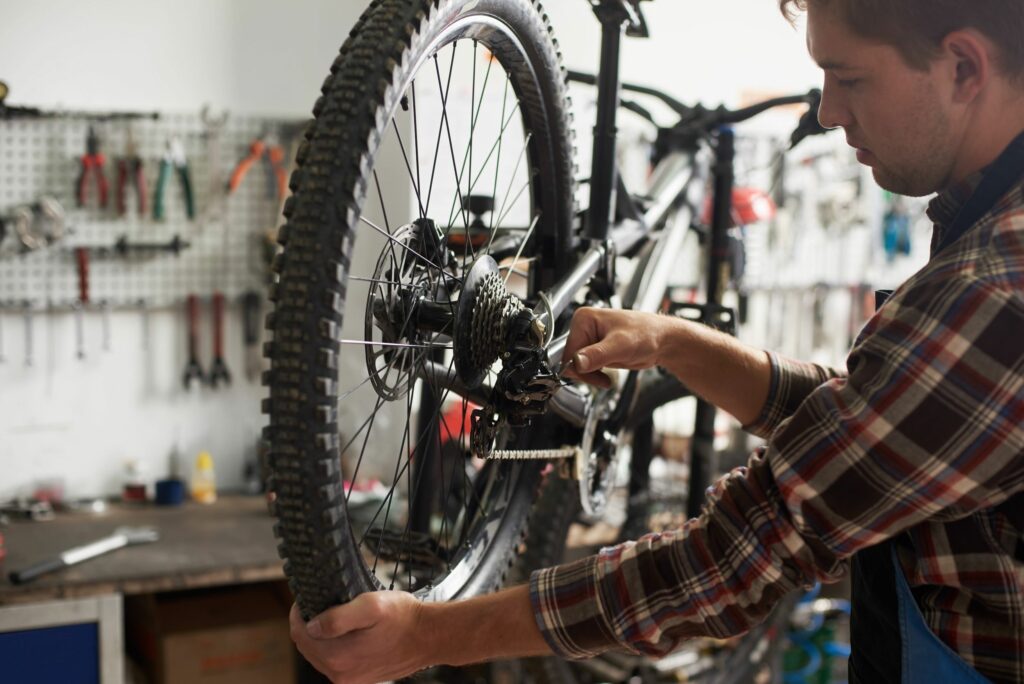Contents
- What will you learn from this post?
- At a glance
- Front derailleur adjustment - what do you need to check before proceeding?
- What will you need to adjust the front derailleur?
- How to adjust the front derailleur?
- Front derailleur cable tension control
- How to adjust derailleurs - front derailleur adjustment
- Congratulations! You have performed a self-adjustment of the front derailleur
You will carry out a lot of simple maintenance at home, which will noticeably improve the comfort of your bike. One of them is the adjustment of the front derailleur. If you know how to do it correctly, you will probably enjoy a flawless drive and fast gear changes. However, if you have never done it – check how to adjust the front derailleur and forget about the problems associated with this component.
What will you learn from this post?
- What do I need to keep in mind before adjusting the front derailleur?
- What tools and accessories are useful for setting the front derailleur?
- How to adjust the front derailleur?
At a glance
Do you feel like the drivetrain on your bike is not working properly? Are you having trouble changing gears? So it’s time to get busy adjusting the front derailleur. This is a fairly simple service activity that you can handle at home. You’ll need some basic tools and a service bike stand, so you can tackle this task in no time.
Front derailleur adjustment – what do you need to check before proceeding?
Before you know how to adjust the front derailleur, you need to make sure what derailleur is installed in your bike. Considering the attachment to the frame, there are 3 main types:
- Direct attachment to the frame – found most often in frames made of carbon.
- Mounting to the bottom bracket axle, or E-Type – nowadays an increasingly rare type of front derailleur.
- Classic clamp.
Here it is worth stopping for a moment and recalling the construction of the front derailleur. It consists of 5 main components – a clamp, 2 adjustment screws (“H” screws and “L” screws), a screw that attaches the cable, and a chain guide. If your bike has a classic bracket, check that the derailleur guide is in the correct position relative to the large disc, i.e. 1-3 mm above its highest point and parallel to it at the same time. If the guide is misaligned, you need to drop the derailleur to the smallest disc and unscrew the screws (from the clamp and the one holding the cable), then adjust the height of the guide. Before adjusting the front derailleur, also check the smoothness of the gear shifter. If you have doubts that it is working properly, apply a few drops of oil to the inside of the armor. The armor itself should be replaced when you notice metal wires standing out. The same for a delaminated or corroded cable – buying a new one is then a necessity. Take care of this before adjusting the front derailleur, or your further efforts will be in vain.
What will you need to adjust the front derailleur?
Setting the front derailleur does not require specialized tools. You will need an allen wrench in size 5 and a classic cross-piece. It’s a good idea to add a service bike stand, which will stably hold your two wheels for the duration of the work. This is actually an essential piece of equipment for any home bicycle workshop. The stand does not take up much space and is solidly made. Most importantly, however, it will save you time. Simple maintenance tasks, such as adjusting the front derailleur, will take you from a few minutes to a maximum of a dozen minutes. The bike stand will hold your unicycle and prevent it from moving freely around the room/garage, so you can focus 100% on your work. It’s also a great way to make a striking display of two wheels when you’re done with your DIY. A 2-in-1 solution at a low price – do you need more as a bike fan?
How to adjust the front derailleur?
Front derailleur cable tension control
- Drop the chain on a small disc.
- Screw the barrel (you’ll find it next to the handlebar) all the way in, turning counterclockwise.
- Make one turn in the opposite direction – this will give you adjustability.
- Unscrew the screw that holds the cable.
- Set the lower range of the derailleur.
- Tighten the line and turn it back.
How to adjust derailleurs – front derailleur adjustment
It is now that your attention should shift to the two adjustment screws mentioned earlier, marked with the letters “H” (from high, for high gears) and “L” (from low, for low gears). The setting of the maximum lean low gears is as follows:
- Place your two wheels on the bike service rack.
- Drop the chain on the middle sprocket of the cassette.
- Set the smallest disc at the front and loosen a little the bolt, securing the derailleur cable.
- Look at the “L” screw – use it to reposition the guide so that it is in the center of the front disc.
- Tension the cable and tighten the bolt – make sure the handle is in the “1” position and the chain is on the smallest dial.
- Put the derailleur on the largest disc and turn the crank. Check that the chain has jumped there.
- Look at the “H” screw – adjust it so that the chain jumps to the center of the sprocket.
- Start changing gears from the middle disc to the smallest disc and vice versa. If you notice that the chain has fallen past the small disc, tighten the “L” screw by ¼ turn (clockwise).
- Re-shift gears. If the chain does not want to come down on the smallest disc, loosen the “L” screw by ¼ turn (this time turning counterclockwise).
This is how the adjustment of low derailleur ratios looks like. And what does it look like for maximum high gear ratios?
- Place the bicycle on the service rack.
- Set the chain on a medium disc.
- Start shifting gears from the center disc to the large disc and vice versa. If the chain falls off the large disc, tighten the “H” screw by ¼ turn (clockwise).
- Re-shift gears. When the chain does not want to return to the medium disc, loosen the screw “H” by ¼ turn, turning counterclockwise.
Congratulations! You have performed a self-adjustment of the front derailleur
All that’s left is to take the unicycle off the service bike rack and perform a test ride. Keep in mind that the drive may initially work differently than you are used to. If you are concerned that the derailleur is not working as it should, gently twist the barrel next to the handlebar. In this way you will adjust the tension of the cable.
Are you looking for a bicycle rack that will come in handy for service work? Check out rtrbikes.com‘s offerings.
Photo source: rtrbikes.com (Remed rack), shutterstock.com



